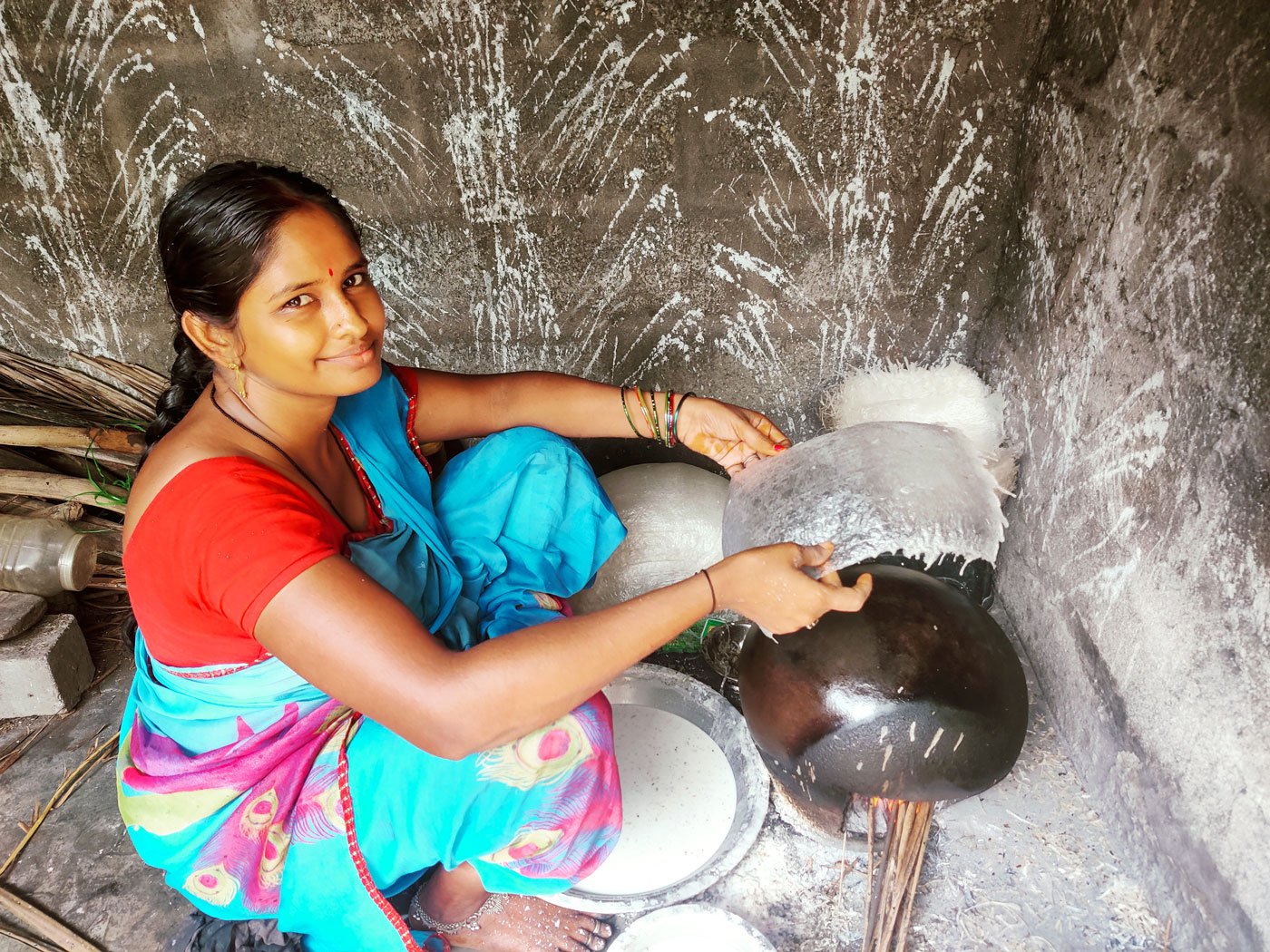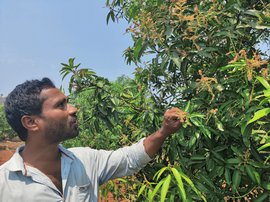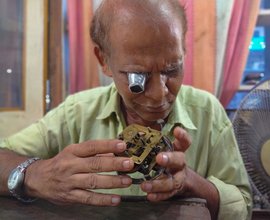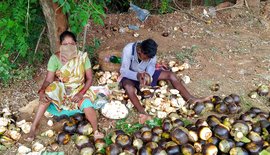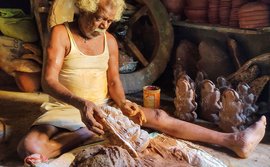Three fingers, a wet rectangular piece of cloth and a light touch. “I have to be very careful.”
Vijaya is talking about making poothareku – a sweet that is local to coastal Andhra Pradesh (AP). Made using fine papery films of rice batter and filled with jaggery, dry fruits and ghee, it’s a festive season sell-out. Skilled sweet maker, Vijaya makes around 200 reku every day and they are picked up by local sweetshops. “I need to concentrate fully when I make poothareku . I can't really talk to anyone,” she tells PARI.
“Any festival, ritual, or any special occasion in my house is incomplete without pootharekulu ,” says G. Ramakrishna. A resident of Atreyapuram, he helps a few shops source packing material and boxes here. “I really like it because it's like a surprise sweet! At first, it looks all papery, and you might think you're eating paper. But when you take a bite, it melts in your mouth. I don’t think there is any other sweet like this in the world,” he declares proudly.
It’s the rice from Dr. B.R. Ambedkar Konaseema district of AP that defines this delicately-fashioned sweet. “The rice is sticky, so no one uses it for anything except making reku [sheet],” says sweet maker, Kayela Vijaya Kota Sathyawati, a resident of Atreyapuram village in Ramachandrapuram division. It is Atreyapuram's poothareku that received a Geographical Indicator (GI) tag in 2023. The GI was awarded to Sir Arthur Cotton Atreyapuram Putharekula Manufacturers Welfare Association in Visakhapatnam on June 14, 2023.
The GI for poothareku i s the third awarded to a food item in the state (the others are the Tirupati laddoo and Bandar laddoo ). Andhra Pradesh has 21 products with a GI under various categories such as handicrafts, food items, agricultural and more. Last year, along with poothareku, Goa’s Bebinca sweet also received a GI tag and previously, Morena's gajak , and Muzaffarnagar's gur also have GIs.


Left: Vijaya’s works in a small corner of her house. She calls this her workspace. It’s filled with the inverted pot, rice batter, dry coconut leaves and an old pickle jar amongst other things. Right: Jaya biyyam is a special kind of rice is used to make poothareku . The rice is soaked for 30-45 minutes before grinding it into a batter that is used to make the thin films or rekulu
Veteran sweet maker, Vijaya has been making reku since 2019 and she says she always has to give it her full concentration. “But I can freely talk to people and make other sweets because they are easier to make," and so she makes sweets for her family – sunnundalu , kova and others. Sunnundalu are laddoos made with roasted and finely ground urad dal and sugar or jaggery, with ghee.
“I wanted to make some money to support my family and myself. There’s no other work I know so I got involved in this,” says Viajaya, explaining how she got into selling the reku to sweet shops. She doesn't make any other sweets for sale.
At the beginning of the month she buys 50 kilos of loose rice in the local market. Only jaya biyyam is used to make pootharekulu and a kilo is priced at Rs. 35. “This rice once cooked becomes very sticky so no one uses it for anything except making reku ,” Vijaya explains.
Her day as a sweet maker begins at 7 a.m. when she starts the process of making
reku
by taking half a kilogram of
jaya
biyyam
which she rinses and covers with water for at least 30 minutes.
After her sons have left for school, Vijaya grinds the soaked rice to a smooth, thick paste. She pours this into a bowl and places it on a little wooden stool outside her house in her small workshop.
Finally, around 9
a.m., in a corner of her workshop, Vijaya begins making the delicate,
gossamer-like
rekulu
using a special
inverted pot with a hole on one side. “This pot is made only in this region,
with the mud found here. Any other pot or vessel can’t be used. The inverted
shape of the
reku
is formed with
the help of this pot,” she explains.


Left: Rice batter and the cloths used to make pootharekulu . Right: Vijaya begins making the reku by dipping a cloth in the rice batter she prepares


Veteran sweet maker, Vijaya has been making reku since 2019 and she says she always has to give it her full concentration. When she dips the cloth in the rice batter and lays it on the pot, a film forms on the inverted pot (right)
The pot is heated by lighting a fire to dry coconut leaves. “Coconut leaves [unlike others] produce consistently high heat by burning quickly. Without the right vessel and heat, the rekulu won’t form,” she says.
“The pot costs
between Rs. 300- 400. I replace it every two to three months. It doesn’t last
longer than that,” she adds. Vijaya buys coconut fronds at the local markets once every two weeks. She
buys 5-6 bunches and each bunch is priced at Rs. 20 - 30. .
While Vijaya’s inverted pot is heating up, she wrings out a clean dry
rectangular cloth piece and wets it. A cotton cloth (from her saree, or
any other clothing) is washed and used for this purpose. She pours the batter
into a larger plate and dips the cloth into the batter.
Vijaya then gently pulls the cloth out and transfers a thin layer of the batter
sticking to the cloth, onto the inverted pot. A wafer-thin grayish-white film
is formed in an instant whilst releasing a lot of smoke. The film sits on the
pot for a few seconds until fully cooked.
The next step calls
for the greatest delicacy of touch. Using no more than three fingers, she
detaches the
reku
from the pot.
“Removing it is the toughest part. If it crumbles, it’s gone. So I have to be
very careful,” even as she deftly removes and places it on a pile next to her. In an hour she estimates she can make
90-100
reku
, and in roughly two to
three hours she has churned out 150-200 of them. On the days leading up to a
festival, the orders touch 500 and she prepares the batter accordingly.


Left: To check if the papery film of rice has formed, Vijaya attempts to nudge it slowly with her fingers. Right: Vijaya uses only a few fingers to separate the thinly formed film from the inverted pot


Shyamala and Sathya working at KK Nethi Pootharekulu shop in Atreyapuram
In Atreyapuram, many women make rekulu , most at home but some in shops as well.
V. Shyamala, 54 works at KK Nethi Pootharekulu – a shop near the Atreyapuram bus stop. She lives around four kilometres away from the shop and has been involved in making the sweet for the last 25-30 years. Shyamala began her career by making reku at home like Vijaya. “I used to make 100 sheets a day and get paid Rs. 25-30 for it,” she recalls. She is primarily involved in the last step of making poothareku: s he folds the reku with sugar, jaggery, dry fruits, a generous amount of ghee, and other fillings. Shyamala says she finds it difficult to walk to her workplace as “my knees hurt.” So her son drops her to the shop every day.
Once she arrives and settles into a small nook behind KK Nethi Pootharekulu shop, she grabs a high metal stool, adjusts her saree and sits where the sun doesn’t bother her too much. She faces the road and can be seen wrapping the poothareku by customers who pass by.
Shyamala gently picks out one reku from the pile beside them and smears it with a generous amount of ghee. She then spreads jaggery powder on it. “For a plain poothareku , that’s all the ingredients,” she says as she places another half reku on it. She then folds it gently to make sure none of the ingredients fall out, taking a little more than a minute to fold one poothareku . They are traditionally folded into a long rectangular shape, but can also be folded in the triangular shape of samosa .
For every
poothareku
that is folded in the shape
of a
samosa
, Shyamala is paid an extra Rs. 3 for it. “Folding in the shape of a
samosa
is hard even for me. I have to be very careful or the
reku
will break,” she says.


Shyamala folds a film of rice paper with dry fruits, jaggery powder and more to make a poothareku . First she gently flattens the film, spreads a few drops of sugar syrup and a then generous amount of ghee after which she adds dry fruits


Shyamala (left) says, 'I have to be very careful or the reku will break.' Packed pootharekulu ready to be shipped
“Plain sugar or jaggery is the original poothareku in my opinion. This is the recipe passed down generation after generation in our village,” Shyamala explains, adding that the addition of dry fruit in the sweet is relatively new.
Shyamala works alongside the shop owner- Kasani Nagasathyawati (36) from 10 a.m. to 5 p.m. on all days except Sunday. She is paid Rs. 400 per day for her work. This amount has not changed for the last three years or even after poothareku got the GI tag.
The GI tag for Atreyapuram poothareku has not had any effect on workers like Vijaya and Shyamala. Their daily wage has not increased since the GI tag was awarded, but they say shop owners and other big vendors seem to be making good profits.
Sathya says that poothareku has always been famous in Telugu states of Andhra Pradesh and Telangana. “But now more people know about it. Earlier we had to explain what poothareku is to people from other states. Now, it needs no introduction,” she says.
Sathya is one of the members of Sir Arthur Cotton Atreyapuram Manufacturers Welfare Association. The Association has been seeking a GI tag for poothareku for over 10 years and so when they were awarded the tag in June 2023, “it was a proud moment for the entire village.”

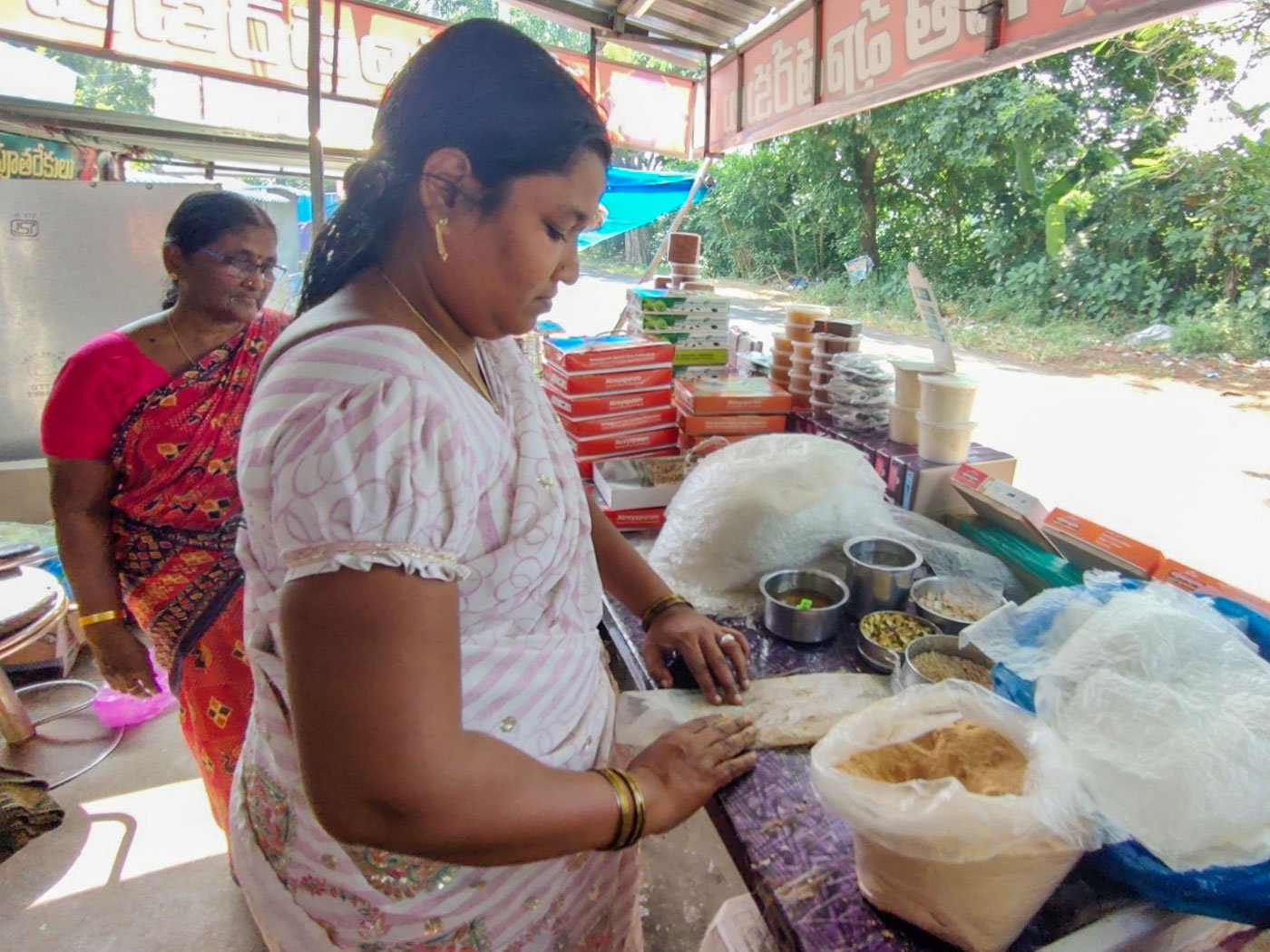
Left: A reku formed over the inverted pot. Right: Sathya began her business in 2018


It’s the rice from Dr. B.R. Ambedkar Konaseema district of AP that defines this delicately-fashioned sweet. 'Any festival, ritual, or any special occasion in my house is incomplete without pootharekulu, ' says G. Ramakrishna, a resident of Atreyapuram
Sathya says that the number of orders at all shops including hers has risen. “Most of our orders come in bulk for 10 boxes to as many as 100,” she says. Each box contains 10 pootharekulu .
“People order from Delhi, Mumbai and so many other places,” she says. “In the village we price each poothareku between Rs. 10-12 and they [big shops outside] charge more than Rs. 30 for one,” she explains.
“The price hasn’t changed much since the GI tag has been awarded,” Sathya explains. “Ten years ago one poothareku was priced at Rs. 7 or so,” she says.
“Last week a girl from Dubai came to my shop. I showed her how pootharekulu is made and she was fascinated by it. She couldn’t believe how the sweet just melted in her mouth. She called the making an art. And honestly, I never thought of it that way. But it’s true - no one can replace all of us who make reku and fold them so perfectly through the year,” she added.
This story is supported by a grant from
Rang De
.
